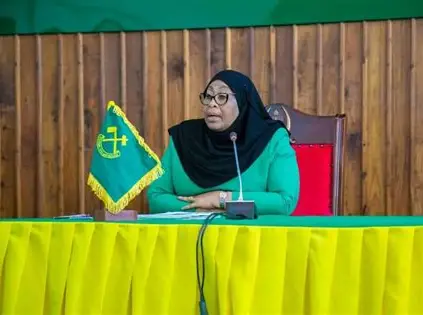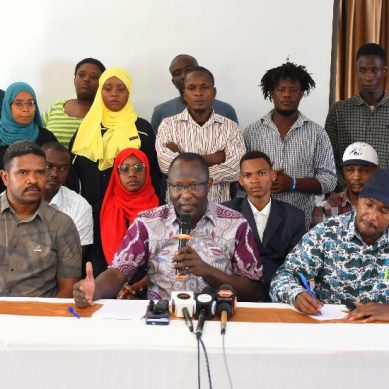
There is something constant and consistent about resurgent African dictatorships: their national and ruling party flags bear the yellow colour. Is it then surprising that countries in Africa with yellow shades in their national symbols experience the most violent elections or bloody uprisings?
The correlation is just coincidental and has nothing to do with ideology.
The latest of these autocracies is Tanzania, where the first woman president in the East African Community (EAC) bloc executed a “civilian coup with military precision” that completes the cycle of post-election violence, which has in the past visited Kenya, Uganda, Rwanda, Burundi, Somalia and Ethiopia.
As soon as the election results were announced that 97 per cent of the vote, Suluhu Hassan boasted she is Tanzania’s Simba Jike (implying marauding Lioness in wilds of Tanzania). The boast carried a poignant meaning: she had against the odds mauled and obliterated the opposition. All bloodhounds in the wilds never operate by rules or decorum.
The boast received an equally poignant response from East Africans who lived in Uganda’s Idi Amin Dada era of bloodthirstiness. They gave her a fitting Idi Amin Mama monicker in reference hundreds of opposition supporters that were assassinated, abducted, detained or vanished through state-enforced disappearances. In the wake of the post-election violence religious leaders, human rights organisations, diplomats and opposition parties say more than 1,000 were shot dead by police and military in the one-week mayhem.
Notably, the inauguration of President Samia Suluhu Hassan was done without the participation of the people she claims gave him 97 per cent of the vote. The election body has been careful not reveal voter turnout that can help shed light on Suluhu Hassan’s sudden popularity. The unprecedented feat is “bettered” on by Paul Kagame of Rwanda who in the last presidential election garnered 99.1 per cent of the vote.
Like their mentor and godfather in Uganda, President Yoweri Tibuhaburwa Museveni, the electoral feat was obtained with main rivals cooling their heels in detention or exile. Museveni, a like a withering flower is 81 years-old and still plans to cling to power. H is the region’s pervasive elections rigger. By being the first – followed by Kenya William Ruto – to congratulate Suluhu Hassan for blatantly rigging the election, he underlined his knack for violating the rules of the game.
In psychology, yellow is associated with the sun and symbolises optimism, joy and enlightenment, but also stands for duplicity, cowardice or betrayal. Historically, ancient Egyptians painted their gods in yellow – the colour of most precious and prized mineral: gold.
Since the fourteenth century onward, yellow has become the colour of envy, jealousy, treason, the colour that cannot be trusted. Once the colour of the sun and gold, yellow became one of the least popular shades. Its dubious reputation endures to this day. Compared to other colours, yellow often stands as a symbol of negative personality traits. Countries and political organisations with yellow as their theme colour, demonstrate this characteristics.
Students of literature teach us that yellow symbolises frailty, withering or lifelessness. Does the yellow in party and national flags echo this meaning or it is just a coincidence? No, it may be coincidence but the consistency in undermining democracy gives that impression.
For example there is the moronic Paul Biya who grabbed eighth straight term in the recent Cameroon’s presidential poll. At 92 years, can Biya inject fresh ideas in Cameroon’s body-politic? Biya does not even remember his own name!
The dominant colour of the ruling party in Kenya – the United Democratic Alliance (UDA) is yellow. Same applies to Uganda’s governing National Resistance Movement (NRM) and the national flag. Chama Cha Mapinduzi (CCM) in Tanzania, which excels in duplicity and treachery has yellow as the second dominant colour, which also features in the country’s national flag.
What is happening in Cameroon and Tanzania or what is also happening in Morocco. It suggests that peace and stability, buildings or providing amenities may not be enough to satisfy humanity.
Humanity loves justice, freedom, human rights, respect, equity and equality far more than things. Good governance will ensure that all those qualities persist and pervade society. Once these qualities diminish no amount of things peace or security will satisfy humanity in the long-term.
Decay and collapse are imminent. Tanzania has been enjoying peace and security since she obtained her political independence in 1961, but is now in chaos. But now peace and security are in the past. The angry people are destroying the economy because their leadership destroyed their trust in institutions.
In Uganda, power has concentrated on peace and security, not to transform society for the better but to enrich a few at the expense of the majority and the environment and to protect their gains. Now Kampala City’s environment has decayed and collapsed instead.
Artificial lakes and rivers now characterise the city and have destroyed goods and services, dispossessed and displaced many, made roads impassable. City residents are angrier than at any other time in the history of Uganda.
It is clear that the regime in power is unable to ensure that Ugandans enjoy a peaceful, secure, safe and clean environment in which they can enjoy unity, respect, justice, equity, equality, human rights and good governance. These have been put in the backyard in order to commit time, energy and money to pursue the selfish interests and protect their gains at the expense of the majority of Ugandans. This is catastrophic.
The ultimate social, political, economic and environmental collapse is knocking at our door. When this happens, we shall have spent 40 years paving the way for it. We shall blame the governors that became short-sighted, selfish and greedy, disrespected Ugandans and denied us the qualities of life that matter.
For God and my country
- A Tell report / By Oweyegha-Afunaduula / Environmental Historian and Conservationist Centre for Critical Thinking and Alternative Analysis (CCTAA), Seeta, Mukono, Uganda.
About the Centre for Critical Thinking and Alternative Analysis (CCTAA)
The CCTAA was innovated by Hyuha Mukwanason, Oweyegha-Afunaduula and Mahir Balunywa in 2019 to the rising decline in the capacity of graduates in Uganda and beyond to engage in critical thinking and reason coherently besides excellence in academics and academic production. The three scholars were convinced that after academic achievement the world outside the ivory tower needed graduates that can think critically and reason coherently towards making society and the environment better for human gratification. They reasoned between themselves and reached the conclusion that disciplinary education did not only narrow the thinking and reasoning of those exposed to it but restricted the opportunity to excel in critical thinking and reasoning, which are the ultimate aim of education. They were dismayed by the truism that the products of disciplinary education find it difficult to tick outside the boundaries of their disciplines; that when they provide solutions to problems that do not recognise the artificial boundaries between knowledges, their solutions become the new problems. They decided that the answer was a new and different medium of learning and innovating, which they characterised as “The Centre for Critical Thinking and Alternative Analysis” (CCTAA)






